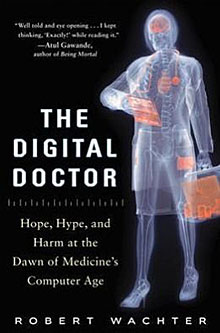Health Care Access & Coverage
News
Inadvertently Disconnecting Place-Based Clinical Communications
How Digitization Can Disrupt The 'Information Geography' of Hospitals
Radiology, which only five years ago was medical students’ most desired career path, is now the least desired — and that precipitous decline is an apt metaphor for the broader unanticipated consequences wrought by the current version of digitized medicine, according to Dr. Robert Wachter.
He pointed out that one of the most troubling aspects of this trend involves the disruption of the “information geography” of hospitals — or those unofficial but critically important hubs of clinician communications, knowledge sharing and team interaction.

Penn’s Imran Cronk Interview with Robert Wachter
Author of the new book, The Digital Doctor: Hope, Hype, and Harm at the Dawn of Medicine’s Computer Age, Wachter, MD, is a Professor and Interim Chair of the Department of Medicine at the University of California, a national authority on hospital safety, and was recently ranked by Modern Healthcare magazine as the most influential physician-executive in the U.S.
At a seminar hosted by the University of Pennsylvania’s Leonard Davis Institute of Health Economics (LDI), Wachter led a standing-room-only audience of faculty and student health services researchers through a litany of ways the first wave of health care computerization has gone awry.
Traditional analog processes
The fundamental problem he detailed is that health care managers and their vendors viewed what they were doing as the digitization of traditional analog processes rather than a complete rethink of how clinical assumptions and workflows would be altered by an interconnected electronic environment.
Radiology, he said, became an early example of that when it was totally digitized fifteen years ago.
“When I was a medical student here at Penn (in the early 1980s), there was no question that the central hub of the hospital was the Chest Reading Room in the radiology department,” Wachter said. Because it was the only place doctors could then view their x-ray films, the radiology department was a lively center of constant gathering, clinical discussions and intellectual ferment.
‘Magical’ knowledge sharing
Those exchanges were magical,” Wachter remembered. “It was not only us front line clinicians learning from the radiologists, but them learning from us as well.”
But the economics of radiology — a technology then moving from a few-films-per-patient mode for standard x-rays to hundreds-of-films-per-patient for MRI and CAT scans — caused the field to rapidly switch to digital imaging as soon as viable film-less systems became available.
“Suddenly, you could read your images anywhere and you no longer had to go to the radiology department,” Wachter said. “Over the course of just a couple of weeks after it went digital, those daily rounds to the radiology department ended. There was a moment when I think some radiologists thought that was a good thing — but they soon realized they had been separated from the front lines of medicine and felt like their value was no longer fully being realized.”
Lost communications path
“The radiology rounds were the thing that we hadn’t realized was really about gathering around the artifact called film,” he said. “When the film went away, so did the communications path and pattern.”
Another hospital area where information geography has been disrupted in a negative way is the nurses’ station, Wachter said. Prior to the widespread use of electronic medical records, that space in the ward was a constant gathering place for both doctors and nurses. Along with working on the paper-based records stored there, the nurses’ station was a hub of constant communications, knowledge sharing, and collegial interaction among team members.
Displaying a photograph of a crowded room of physicians at desktop computer screens in his own hospital’s 9th-floor resident physicians’ room, Wachter then showed a photograph of a vacant corridor and nursing station on the 14th-floor patient wards.
Wards devoid of doctors
“The ward is devoid of doctors because the minute they are done, they leave the 14th floor to go work on electronic medical records in their own tribal room on the 9th floor,” said Wachter.
“In the old days, they had to hang out at the nurses’ station, which is where they read notes, wrote notes, read labs and consults,” Wachter continued. “Now, they are no longer tethered to the floor by paper charts and therefore, they leave. And that is a big deal because we spent a lot of energy trying to improve the collaboration of nurses and doctors and this new pattern is a hand grenade thrown into all of those efforts.”
“The point being that the geography and communication patterns really change once you go digital and you have to think about that,” Wachter said, “and I can tell you we gave that no thought whatsoever when we went digital.”